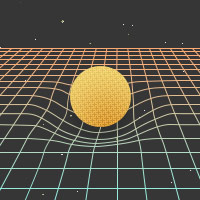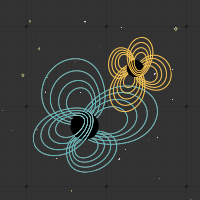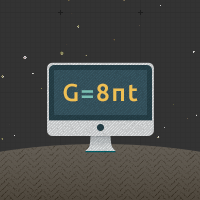Why Numerical Relativity?
Calculating Physics
Einstein gave us a beautiful, and — in some sense — very elegant description of physics with his equation
This basic equation encodes all of gravity; it forms the most essential piece of the puzzle in any understanding of the physical world. In principle, if we know everything on both sides of this equation at one moment in time, we can use it figure out everything at all moments in time. That is, we can figure out what the shape of spacetime is, where all the matter is, and where it is going. Unfortunately, this elegant form of the equation is almost completely useless for doing calculations. In order to accomplish anything, a physicist intending to use Einstein's Equations must begin a very complicated analysis, involving huge amounts of algebra and calculus.
The Difficulties of Solving Einstein's Equations
For most problems, physicists need to use the same equation above in a fuller form. There are ten distinct equations that come out of this. By using a few abbreviations, we can make things look comparatively nice, and fit this more full form on one page. (See the box below.) Conceptually, the equations just describe the change in the metric from point to point. They do it in a pretty complicated way, though. Unfortunately, this is how Einstein's equations must be used if we want to tackle real-world problems and figure out actual answers with them.
To write the easy form of Einstein's equations, we first define a new set of numbers:
$$\Gamma^\alpha_{\beta\gamma} = \frac{1}{2}\sum_{\delta =x,y,z,t}g^{\alpha \delta }\biggl(\frac{\partial g_{\delta\beta}}{\partial x^{\gamma}} + \frac{\partial g_{\delta\gamma}}{\partial x^{\beta}}-\frac{\partial g_{\beta\gamma}}{\partial x^{\delta}}\biggr)$$
The Greek letters \(\alpha\), \(\beta\), \(\gamma\), and \(\delta\) can each be replaced by any of the letters \(x\), \(y\), \(z\), or \(t\). The \(\Sigma\) symbol is a sum. The symbol \(g^{\alpha \delta }\) is essentially the same thing as the metric, \(g_{\alpha \delta }\), but with slightly different numbers. Terms like \(\frac{\partial g_{\delta\beta}}{\partial x^{\gamma}}\) represent the change in the metric from point to point along the lines of our coordinate grid. With this definition, Einstein's equations become
\begin{align}8πT_{\alpha\beta} = &\sum_{\delta} \Bigg[\frac{\partial\Gamma^\delta_{\alpha\beta}}{\partial x^\delta} - \frac{\partial\Gamma^\delta_{\delta\beta}}{\partial x^\alpha} + \sum_{\gamma} (\Gamma^\delta_{\alpha\beta} \Gamma^\gamma_{\delta\gamma} - \Gamma^\delta_{\gamma\beta} \Gamma^\gamma_{\delta\alpha})\Bigg] \\&- \frac{1}{2} g_{\alpha\beta} \sum_{\delta}\sum_{\gamma} \Bigg\{g^{\delta\gamma}\sum_{\mu} \Bigg[ \frac{\partial\Gamma^\mu_{\delta\gamma}}{\partial x^\mu} - \frac{\partial\Gamma^\mu_{\mu\gamma}}{\partial x^\delta} + \sum_{\gamma} (\Gamma^\mu_{\delta\gamma} \Gamma^\nu_{\mu\nu} - \Gamma^\mu_{\nu\gamma} \Gamma^\nu_{\mu\delta})\Bigg] \Bigg\}\end{align}
Since the Greek letters are standing in for real letters, there are actually sixteen copies of these equations! Granted, six of those are unnecessary, but that's still a lot of equations. And, we're using abbreviations. To write all of these ten equations out in terms of the metric alone - without any abbreviations - would take roughly a hundred pages! If this doesn't seem very "easy" to you, you are not alone.
Now, in some situations, these complicated equations can be simplified. For instance, if we are looking at empty space with no matter in it, the Stress-Energy tensor (the \(T\) above) disappears, so one side of Einstein's equations is just zero. If the Universe is the same in every direction, no matter which way you look, all but two of Einstein's equations disappear. In many interesting physical situations, these types of simplifications are good enough to describe the real Universe quite well. These tricks allow us to understand what must have happened following the Big Bang.
The space around a quiet, non-spinning Black Hole is simple enough that it was first analyzed and understood by a German soldier serving on the Eastern front during World War I, just months after Einstein introduced his equations to the world. Conditions were grim; the soldier died shortly after writing to Einstein describing his discovery. Nonetheless, he was able to solve Einstein's Equations in these circumstances, using just pencil and paper.
If gravity is weak, most of the terms in Einstein's equations are quite small, and so can be ignored. This — along with the knowledge of a few more tricks — allows us to analyze gravitational waves with Einstein's equations. The analysis is not perfect, since it is only an approximation, but it is a very precise approximation, and the errors from the perfect solution are tiny.
Of course, not all of Nature is quite so simple. If we want to know what Einstein's equations say about two black holes with different masses falling into each other, for example, we have to use every one of the terms in all ten of the equations. There are no simplifications that Nature will respect in this case. In this state of affairs, Relativity as a tool for understanding interesting physics seems hopelessly lost. There are too many equations, with far too many terms, for any human to even keep track of — never mind solve.
The Initial-Value Formulation and Computers to the Rescue
In their form above, Einstein's equations have to be solved everywhere throughout spacetime, all at once. Thankfully, methods have been found which allow us to just solve on one slice of space (no time), and them step forward in time from there.
The Achievements Possible with Numerical Relativity
Templates for GW observatories make these observations possible. New physics, bringing us greater understanding of the implications of Einstein's equations.






